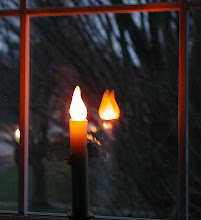NOAA Ice Cover On The Great Lakes
My mother has been looking north for a month or so and wondering what those "salties" (ocean sailing vessels) were doing anchored just north of the Blue Water Bridge at the very southern end of Lake Huron. I have seen ships at anchor before, so I did not think much about it.
When I finally began to think about it, I could not figure out why they were there. I did not even know if they were the same ships, or whether some went their way, only to be replaced by new laggards.
I even let myself imagine that they were waiting for dock space in Goderich, Ontario, which is the only possible port in the immediate 60 mile radius taht might have large tonnages being exported. Since Goderich was mostly shipping salt, it made sense at a different time of year, not after winter, but I needed an explanation, so I gave the Goderich explanation its day in the sun.
My mother and I like such analytical speculations.
The notion of going to the Internet is quite impossible, since she is dead set against computers, judging them a scheme to steal her ID.
She also cancelled the newspaper, which had become a 16 page expense of little interest other than local ads for sales.
We drove up the lakeshore and counted 14 ships.
It turns out that these ships are waiting for the ice to clear from their destinations on the Great Lakes. Some have been waiting for a month. New ones arrive and drop anchor. They may be headed to ports of lesser size and importance and cannot get an icebreaker escort.
If I had paid attention, I could have gotten a couple of large pontoon scows and provided victuals and wet goods. Some of the ships have run out of coffee, and have had their larders replenished.
I do not remember such a long wait for ice to clear.
I think this winter was colder for a longer time than any previously, even though the Coast Guard says that the winter of 1979 had more ice cover. They do speculate that this year's will take longer to dissipate, estimating the ice to be in the lake until June.
Duluth News Tribune
Will Lake Superior still have ice in June?
By Mike Creger on May 1, 2014 at 3:03 p.m.
http://www.duluthnewstribune.com/content/will-lake-superior-still-have-ice-june
Ice continues to be a problem on the lake, especially around the Duluth and Superior entries after the wind-whipped storm earlier this week shoved ice in.
Mark Dobson, a vessel traffic manager at the Soo Locks, said ice had loosened across the Great Lakes and ships were moving, only to be stalled by the gale warnings. On Tuesday, several upbound ships waited in Whitefish Bay, next to Isle Royale or other calm points.
“The ice is getting sparse, especially after the storm blew through,” Dobson said. He said the wind was a setback for traffic “but might be a blessing” in clearing locked-in ice. “Every day is another improvement.”
Ships are still being escorted with ice breakers on Superior, so the clump of those seen coming into Duluth on Wednesday will likely be repeated in coming days. Nine upbound ships were just north of Whitefish Bay on Wednesday afternoon, headed to ports west.
The pickup in traffic pleases Glen Nekvasil, vice president of the Lake Carriers’ Association. Shipments on Superior, the home of five iron ore ports and vital coal links, were sparse in April.
“It’s pretty obvious it’s going to be significantly reduced,” Nekvasil said of the expected monthly tonnage report he files.
He groans about a poster ship for the slow season dealing with braking ice: an ore carrier that left the North Shore March 23 and didn’t make its delivery until April 23. Lakers usually can make four trips in 30 days under clear sailing, Nekvasil said.
“This is the worst,” he said, recalling past benchmarks for ice and slow seasons in 1976 and 1994, a year when cutters broke ice until May 18. Not having access to the ports at Thunder Bay, Duluth, Superior and along the North Shore has a huge effect on the whole of the Great Lakes commerce. Steel mills have had to idle or conserve while waiting for taconite.
[...]
George Leshkevich is an expert on Great Lakes ice as a scientist for the National Oceanic and Atmospheric Administration in Michigan. He said he wouldn’t be surprised if there was ice on Superior in June.
[...]
He said ice on the lake this year compares to 1979 in terms of coverage, with about 67 percent iced over on the comparable date of April 23.
He’s still running the numbers, but 2014 looks like “there’s going to be even more” lingering ice than in 1979. “This year is maybe a record-breaking year."
The Whitefish Bay Waiting For The Thunder Bay To Leave The Ice At Duluth
(April 30, 2014 - facing south)
***
addendum
http://www.boatnerd.com/news/news14.htm
Lake Huron remains a wet parking lot: Freighters are waiting for ice to clear
5/3 - Port Huron, Mich. – Jeannette Zells, of Avoca, counted the 14 freighters anchored in lower Lake Huron on Thursday while she ate her lunch at Lakeside Beach. The spectacle, which started last week, likely will continue for another week or two.
“I was eating my lunch when I saw them,” Zells said. “First I just counted four, then seven, and then I realized there were 14. I had to take pictures, I love freighter watching, and I have never seen them this backed up before.”
Ice in Lake Superior and the St. Marys River like a traffic accident on a terrestrial highway caused the freighter jam.
“This is very unusual,” said Frank Frisk, Great Lakes Maritime Center in Port Huron consultant. “It has only happened a few times, and it is worse than before.”
Freighter watchers might be getting a treat, but the backup is a problem for industries that rely on freighters for commodities such as iron ore and coal.
“Steel mills are hurting from a lack of iron ore and power plants have reported that their coal inventory is very low,” Frisk said. “And there is currently a big demand for steel right now since the economy is moving in a positive direction – automobiles, bridges, and buildings all need steel to be produced.”
One ship that set sail on March 23 did not deliver its first cargo until April 23, said Glenn Nekvasil, Lake Carriers’ Association vice president.
“Normally a ship would deliver four cargoes in one month,” Nekvasil said. “But this reminds me of the winter of 1994 when we were breaking ice in the St. Marys River until May 18.”
He said some manufacturers have had to curtail production because they lack raw materials.
“Ice is part of sailing the Great Lakes, but this is extreme,” Nekvasil said.
Lake Superior’s ice coverage is 40 percent, a 20 percent decrease from last week, said Mark Gill, U.S. Coast Guard director of vessel traffic services at Sault Ste. Marie. “Each wind event is drawing the ice down more and more,” Gill said. “But some of the floes still have a solid 18 to 24 inches of ice and are several hundred feet in diameter, so it’s still pretty substantial.”
In 2013, ice breaking was done by April 20. Currently, the U.S. Coast Guard has eight vessels working along with two Canadian Coast Guard vessels.
“So far we have had a 60 percent increase from last year in the amount of ice cutting hours logged,” Gill said. “We are probably looking at four more weeks of ice still.”
Gill said the ice could clear sufficiently to allow for normal traffic movement in 10 to 14 days. Until then shipments will continue to take two to three times longer than usual, Gill said.
Nekvasil said Thursday was the last day of convoys led by Coast Guard icebreakers.
“I’m not saying we won’t still have problems,” Nekvasil said. “But it is safe for the freighters to move on their own. We might still need to call the Coast Guard if a freighter gets stuck, but after today they are on their own.”
Freighters have had to wait for a convoy before they could head north, said Donna Wiliamson, Western Great Lakes Pilot District 3 chief dispatcher.
“There have also been delays because we have needed two pilots to accompany each captain through District Three, when normally just one pilot is necessary,” Williamson said. “The pilots from each district help the captains navigate the waters since they are experts of the Great Lakes and its ports.”
District 3, which comprises Lakes Superior, Huron and Michigan, has 13 available U.S. pilots and three Canadian pilots.
“The one good thing is that this summer season the water levels will be raised a considerable amount for commercial traffic,” Frisk said.
Karen Hadden, of Richmond, recalled only seeing so many freighters lined up when they were stuck in ice, and never at this time of year.
“Normally there is not so much ice to the north of us,” Hadden said. “I just wonder what they do out there on the ships all day since they can’t move.”
--



















No comments:
Post a Comment